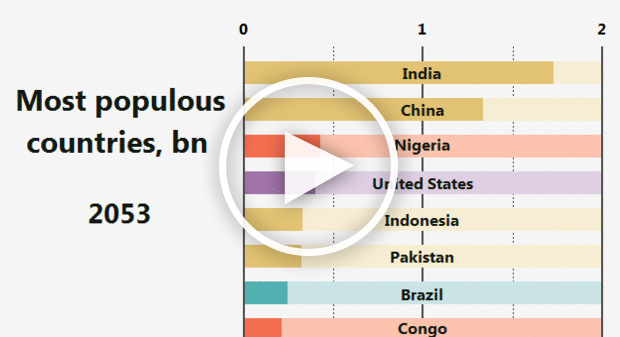Animation: 100 Years of the Most Populous Countries
“I think ageing demographics is a bigger issue in China than people think. And the problems it creates should be become evident as early as 2016.” – Stan Druckenmiller, a 2013 quote Over the last year, we’ve been very skeptical of the near-term potential for robust global economic growth. The media narrative throughout 2015 was that U.S. rates were on the rise, and that the American economy would finally normalize post-crisis. Stock and real estate prices reached record highs on this optimism, and many pundits expected growth and interest rates to return to more traditional levels. Over the last few months, we’ve noticed that this narrative has changed significantly. Even though the U.S. is doing “okay” for growth, the global economy is now more entwined than ever. It’s more challenging than ever before for one economy to prop up the rest during stagnation. Markets this year got off to their worst-ever start after jitters from China rippled through international markets. Oil has continued its plunge and is now trading near $30/bbl. Manufacturing is slowing in the United States. Europe and Japan are going nowhere, and the amount of global debt is starting to signal alarm bells. Finally, media and investors are accepting the idea that things may not normalize the way they “should”. Instead, the question has become more fundamental: are there even any bright spots in the first place?
Back to Basics
We welcome this new found skepticism, and over the coming months part of our focus here will be to go back to the basics. Markets aren’t rational, but we can still aim to provide rational context around the fundamentals of the market. In the long run, we believe this will help investors and regular people understand the world better. A big part of this fundamental approach is demographics, or the changing composition of population over time. Today’s animation, which covers the change in populations over 100 years for the most populous countries, is a starting place for this. The first point of interest is that by about the year 2000, all European countries dropped out of the rankings. At the beginning of the animation, the United Kingdom, Germany, France, and Italy were all there. Birth rates have declined to the lowest in the world, which establishes immigration as the only potential option for economic growth. With the recent events in Paris and the current backlash against Middle Eastern immigrants, this Catch-22 becomes even more interesting and important. Germany, in particular, faces a crucial demographic cliff. We aim to cover this in the very near future, since the country is an important engine for Europe. Another major point of interest, as we referenced in the opening quote, is the changing demographics of China. In the next decade or so, China’s population will stop growing altogether – and then it will start shrinking. This is the predictable aftermath of China’s one-child policy for many decades. The country still has a giant portion of the population that will continue to move up the ladder economically, but we will be looking at what these circumstances could mean as they loom closer. Lastly, the rise of India and Nigeria can’t be understated in importance. Both are home to the fastest growing cities in the world. Nigeria will pass the U.S. to become the third largest country in the world by population in the coming decades, and India could be the world’s next China. When will this potential growth factor into the economy and investments? That’s something else we plan to look at as it becomes more relevant. Original graphic by: Aron Strandberg
on The good news is that the Federal Reserve, U.S. Treasury, and Federal Deposit Insurance Corporation are taking action to restore confidence and take the appropriate measures to help provide stability in the market. With this in mind, the above infographic from New York Life Investments looks at the factors that impact bonds, how different types of bonds have historically performed across market environments, and the current bond market volatility in a broader context.
Bond Market Returns
Bonds had a historic year in 2022, posting one of the worst returns ever recorded. As interest rates rose at the fastest pace in 40 years, it pushed bond prices lower due to their inverse relationship. In a rare year, bonds dropped 13%.
Source: FactSet, 01/02/2023.
Bond prices are only one part of a bond’s total return—the other looks at the income a bond provides. As interest rates have increased in the last year, it has driven higher bond yields in 2023.
Source: YCharts, 3/20/2023.
With this recent performance in mind, let’s look at some other key factors that impact the bond market.
Factors Impacting Bond Markets
Interest rates play a central role in bond market dynamics. This is because they affect a bond’s price. When rates are rising, existing bonds with lower rates are less valuable and prices decline. When rates are dropping, existing bonds with higher rates are more valuable and their prices rise. In March, the Federal Reserve raised rates 25 basis points to fall within the 4.75%-5.00% range, a level not seen since September 2007. Here are projections for where the federal funds rate is headed in 2023:
Federal Reserve Projection*: 5.1% Economist Projections**: 5.3%
*Based on median estimates in the March summary of quarterly economic projections.**Projections based on March 10-15 Bloomberg economist survey. Together, interest rates and the macroenvironment can have a positive or negative effect on bonds.
Positive
Here are three variables that may affect bond prices in a positive direction:
Lower Inflation: Reduces likelihood of interest rate hikes. Lower Interest Rates: When rates are falling, bond prices are typically higher. Recession: Can prompt a cut in interest rates, boosting bond prices.
Negative
On the other hand, here are variables that may negatively impact bond prices:
Higher Inflation: Can increase the likelihood of the Federal Reserve to raise interest rates. Rising Interest Rates: Interest rate hikes lead bond prices to fall. Weaker Fundamentals: When a bond’s credit risk gets worse, its price can drop. Credit risk indicates the chance of a default, the risk of a bond issuer not making interest payments within a given time period.
Bonds have been impacted by these negative factors since inflation started rising in March 2021.
Fixed Income Opportunities
Below, we show the types of bonds that have had the best performance during rising rates and recessions.
Source: Derek Horstmeyer, George Mason University 12/3/2022. As we can see, U.S. ultrashort bonds performed the best during rising rates. Mortgage bonds outperformed during recessions, averaging 11.4% returns, but with higher volatility. U.S. long-term bonds had 7.7% average returns, the best across all market conditions. In fact, they were also a close second during recessions. When rates are rising, ultrashort bonds allow investors to capture higher rates when they mature, often with lower historical volatility.
A Closer Look at Bond Market Volatility
While bond market volatility has jumped this year, current dislocations may provide investment opportunities. Bond dislocations allow investors to buy at lower prices, factoring in that the fundamental quality of the bond remains strong. With this in mind, here are two areas of the bond market that may provide opportunities for investors:
Investment-Grade Corporate Bonds: Higher credit quality makes them potentially less vulnerable to increasing interest rates. Intermediate Bonds (2-10 Years): Allow investors to lock in higher rates.
Both types of bonds focus on quality and capturing higher yields when faced with challenging market conditions.
Finding the Upside
Much of the volatility seen in the banking sector was due to banks buying bonds during the pandemic—or even earlier—at a time when interest rates were historically low. Since then, rates have climbed considerably. Should rates moderate or stop increasing, this may present better market conditions for bonds. In this way, today’s steep discount in bond markets may present an attractive opportunity for price appreciation. At the same time, investors can potentially lock in strong yields as inflation may subside in the coming years ahead. Learn more about bond investing strategies with New York Life Investments.




























